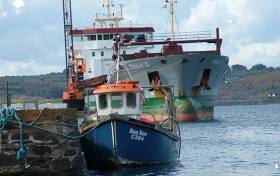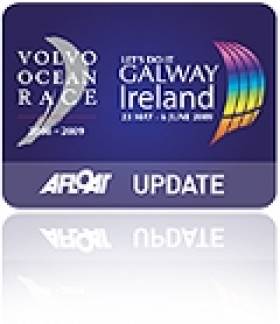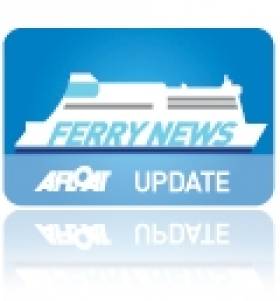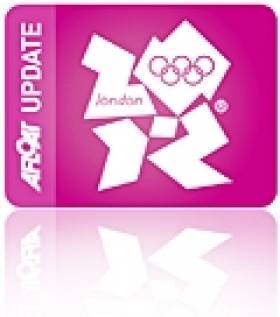Displaying items by tag: Docks
Sailing By & What You Didn’t Hear About Admiral Nelson
When that lovely piece of music, SAILING BY, rolls from the studio presentation desk through my headphones, I feel a sense of enjoyment at being able to bring a wide tapestry of news, information, stories about the culture, history and the maritime tradition to listeners so many of whom tell me that Ronnie Aldrich’s playing of the programme’s theme music on the LP ‘Sea Dreams’ sets the scene for them. I hope it does for you too because, sitting in the studios of Community Radio Youghal on the East Coast of County Cork, where the sea rolls in from Capel Island and other offshore points, my intention is to make a programme bringing together the maritime community. The response is encouraging and I am grateful to listeners who regularly suggest story lines. The current edition is my 46th programme from the radio studios in Youghal, a town with a huge maritime tradition. It was once the biggest port in the Republic. It was a town with a great schooner tradition, trading to the British coast. There were tragedies when families suffered great losses. The town was chosen as the location for the filming of the famous ‘Moby Dick’ epic. It has gone through a period of industrial decline. Every year it remembers those who have died at sea. It is again looking to build up its maritime resources. It has potential as a cruising port-of-call.
I have devised the programme as Ireland’s maritime programme, broadcast through the community radio service and on Afloat.ie to highlight the importance of the maritime sector to an island nation. The programme of news, stories and information from around the Irish coastline, rivers and lakes, connects the ‘family of the sea’ and relates this connection to the oceans of the world.
In the current edition we travel from Bloody Foreland in County Donegal where we hear about navigational changes noted by the Commissioners of Irish Lights, through connections in Offaly to Dublin Port’s famous Diving Bell and a new song about it by an Irish balladeer who has moved from Liffeyside to Holland. He gives us the honour of being the first to broadcast his composition. With a call to Cork to meet ‘the Irish father of ocean energy,’ and hear how he is concerned about lack of public knowledge of the value of marine energy, we are told a story that has not been mentioned in other media as they recall the blowing up of Nelson’s Pillar in Dublin 50 years ago. There is much more to know about Admiral Nelson as we hear how he defended an Irish revolutionary who wanted to kill the King of England. Together with reports from lifeboat stations around the country and the dominance of Clare in lifesaving, all of these stories make up the wide maritime tapestry of the latest edition of THIS ISLAND NATION which you can hear here.
I hope, like myself, that you enjoy this voyage around the maritime sphere of Ireland and, if you would like to contact the programme, the Email address is: [email protected]
Liverpool’s Docks Exhibition Explores History of Merseyside's Maritime Past
This story of Liverpool’s docks will be told time in a brand new exhibition at the Merseyside Maritime Museum, called On the Waterfront, opening on Wednesday 25 November 2015.
Liverpool’s docks transformed the fortunes of the city. Their story is a 300–year journey that turned a small, regional port into one of the world’s great maritime centres.
Marking the 300th anniversary of the city’s Old Dock - the world’s first commercial wet dock– this exhibition covers the period from the 18th century up to the present day. Personal stories show how the waterfront has changed and the impact it has had on the city and the lives of local people.
In addition to stunning photographs of waterfront workers and buildings throughout Liverpool’s history, visitors will be able to see the first-known painting of Liverpool; the itinerary for Prince Albert’s visit to the city to christen the Albert Dock, and a register of vessels showing the first ship using the new Albert Dock in 1846, in addition to huge dock scales used to weigh cargo.
A section dedicated to the Three Graces will include reproductions of two newly donated Stewart Bale images of the Cunard building under construction, which have never been displayed before. They show the construction of the iconic Liverpool building during World War One and one of the photographs, dated 1913, is now the oldest image held by the Museum within its Stewart Bale collection.
The exhibition also recognises 21st-century changes to the waterfront including another National Museums Liverpool’s venue, the Museum of Liverpool. Opened in July 2011, this Museum revived the area as the bridge between the Albert Dock and the Pier Head, allowing people to walk the length of the city’s waterfront to take in not only the Museum of Liverpool but attractions including the Merseyside Maritime Museum, International Slavery Museum and Tate. The Museum of Liverpool has received more than 3.8 million visitors since first opening, and became England’s most visited museum outside of London in 2012.
Ian Murphy, Deputy Director, Merseyside Maritime Museum, said:
“The landscape of Liverpool’s maritime heritage is now a defining symbol of the city and forms part of its World Heritage Site. On the Waterfront is a record of the changing fortunes of the port, the city, and its people. It’s an important story and we are delighted to be able to tell it on the historic 300th anniversary year of the opening of Liverpool’s Old Dock, the world’s first commercial wet dock.
“Merseyside Maritime Museum itself was once a warehouse for high value goods like tea, silk, sugar and spirits in the Port of Liverpool’s Albert Dock - a powerhouse of industry. While Liverpool’s docks relocated downriver towards Seaforth, the building fell into disrepair as part of the wider decline and fall of the city’s traditional docks.
“But in 1986 the building reopened as the Merseyside Maritime Museum – the first public building to open at the dock -starting the renaissance of the waterfront, and becoming the venue we know today; one of the most visited museums in the region. This building is a perfect encapsulation of the story we are showing in the wider exhibition - the changing fortunes of the docks - and we are proud to be opening it here”.
Sue Grindrod chief executive of Albert Dock Liverpool added:
"The heritage of Albert Dock is rooted in its life as a thriving hub at the heart of the Port of Liverpool, almost 170 years of history is in the walls of these grade I listed buildings. The Dock remains today a thriving place to live, work and play at the centre of the developing Liverpool Waterfront and we welcome the addition of Waterfront 300 to share in the journey of this much loved Dock.”
Ian Pollitt, Development Investment Surveyor, Peel Holdings (Land and Property) Limited said:
“The city's docks are famous around the world and we look forward to seeing the new exhibition which I'm sure will be fascinating.
“Anyone who visits the city understands the key role the docks play in today's Liverpool. That role is set to grow in importance as we continue to make the most of the city's best asset: its waterfront”.
Green Dragon Sails Again
Ireland's Volvo 70 the Green Dragon was back on the water again yesterday, two years after she had finished fifth out of seven entries in the 2009 Volvo Ocean Race.
Attempts to sell it for two million euros in 2009 did not materialise. Since then, the round the world yacht has been in dry dock in Galway, rendered obsolete because her hull was heavier and keel lighter than her rivals.
In spite of the disappointing performance the boat was welcomed in to Galway after the 2009 Transatlantic leg by a huge crowd and a week long celebration that has subsequently set the bar for all other stop over ports in the 2012 race.
After being refitted and repaired recently, the Green Dragon sailed out of Galway Docks yesterday for a tour of the bay, before she sets sail for Holland tomorrow.
Ireland's entry in the 2008-9 Volvo entry race will be taking part in the Frankfurt Motor Show promoting the Volvo Ocean Race 2012 and the Global Village in Galway where the race will end next July.
Speaking to Galway Bay FM News, Green Dragon Chairman of Let's Do it Global Enda O'Coineen says 'the sail went great'.
Ferry Falls from Crane in Galway Docks
An investigation is underway into an incident in Galway Docks this morning after a ferry being loaded onto a cargo ship snapped, injuring three men, according to news reports.
A sling that was being used to lift the ferry onto the cargo ship, snapped and the ferry fell 12 metres (40ft) into the water.
Three men have been taken to hospital. They were involved in the loading of a passenger ferry, Clann Na nOilean, onto a large ocean-going freight carrier in the harbour.
All further work on the removal of two passenger ferries at the docks has now been suspended. RTE News has a dramatic picture of the incident here.
Latest Ferry News
Latest Ports and Shipping News
Superyacht Fleet Expected to Visit London Olympics then Ireland
London is expected to provide a great SuperYacht venue for the Olympics and the hope is that some of the massive visitors may in turn continue cruising in Ireland according to www.YachtsLondon.com who are providing services to help yachts arrange to visit in 2012.
There are only a handful of capital cities that can accommodate SuperYachts in their hearts and London is one of these with its iconic river views of Tower Bridge, Greenwich, the O2 Dome and the Canary Wharf financial district.
A legacy of London's place at the centre of world trade in the past are its remaining docks which will provide high quality stern-to mooring for 50-100 large yachts as demand warrants. Canary Wharf will be the centre of this with added space in the Royal Docks next to City Airport. Yachts up to 200m LOA and 30m beam can be accommodated.
Hugh Agnew, one of the principals of YachtsLondon said that "many parties will be involved including dock owners, landowners, pier operators, PLA, MCA, security and suppliers. We can help with all of these, but the key at the moment is early decisions so that sufficient dock space is put in place for 2012."
As well as the Olympic Games there are many other events in the UK in 2012 including Superyacht Cup, J Class regattas, Westward Cup so if there was ever a year to plan to make UK the destination then 2012 will be it with the possibility to link to cruising in Ireland, Scotland and Scandinavia.



























































